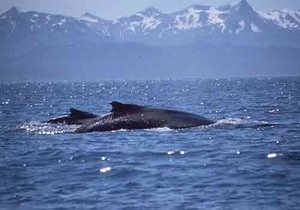Leading scientists call for reducing ocean noise
Bioacoustics, News, Ocean, Science, Seismic Surveys, Shipping, Sonar Add comments Two of the US’s most widely-respected ocean bioacousticians have called for a concerted research and public policy initiative to reduce ocean noise. Christopher Clark, senior scientist and director of Cornell’s Bioacoustics Research Program, and Brandon Southall, former director of NOAA’s Ocean Acoustics Program, recently published an opinion piece on CNN that is well worth reading in full. They stress the emerging scientific awareness that chronic moderate noise from shipping and oil and gas exploration is a more widespread threat to marine life than the rare injuries caused by loud sound sources like sonar. Here are a couple of teasers:
Two of the US’s most widely-respected ocean bioacousticians have called for a concerted research and public policy initiative to reduce ocean noise. Christopher Clark, senior scientist and director of Cornell’s Bioacoustics Research Program, and Brandon Southall, former director of NOAA’s Ocean Acoustics Program, recently published an opinion piece on CNN that is well worth reading in full. They stress the emerging scientific awareness that chronic moderate noise from shipping and oil and gas exploration is a more widespread threat to marine life than the rare injuries caused by loud sound sources like sonar. Here are a couple of teasers:
Today, in much of the Northern Hemisphere, commercial shipping clouds the marine acoustic environment with fog banks of noise, and the near continuous pounding of seismic airguns in search of fossil fuels beneath the seafloor thunder throughout the waters. In the ocean’s very quietest moments, blue whales singing off the Grand Banks of Canada can sometimes be heard more than 1,500 miles away off the coast of Puerto Rico. But on most days, that distance is a mere 50 to 100 miles.
Whales, dolphins and seals use sounds to communicate, navigate, find food and detect predators. The rising level of cumulative noise from energy exploration, offshore development and commercial shipping is a constant disruption on their social networks. For life in today’s ocean, the basic activities that we depend on for our lives on land are being eroded by the increasing amount of human noise beneath the waves.
These stark realities are worrying. But emerging technologies for quantifying and visualizing the effects of noise pollution can help drive a paradigm shift in how we perceive, monitor, manage and mitigate human sounds in the ocean. Ocean noise is a global problem, but the U.S. should step up and lead the way.
Clark and Southall make three specific recommendations: to establish a more comprehensive network of acoustic monitoring stations in order to better understand our overall acoustic footprint in the seas; to encourage and accelerate development of noise-reduction technologies (especially to make ships quieter, and also to develop new technologies for oil and gas exploration and underwater construction that generate less noise); and a shift in federal regulations from avoiding acute injury, toward protecting ocean acoustic habitats and ecosystems.
